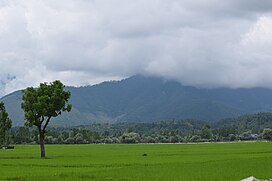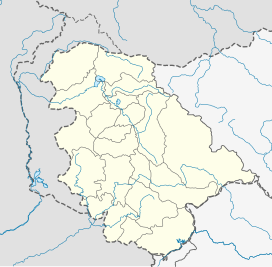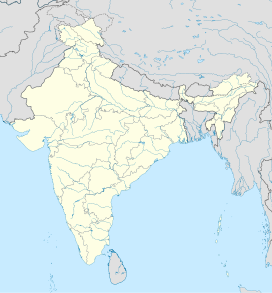Lolab Valley
| Lolab Valley وادیِ لولاب | |
|---|---|
| Lolo لولو | |
 Lolab Valley | |
| Floor elevation | 5,464 ft (1,665 m) |
| Length | 16 mi (26 km) |
| Width | 3.10 mi (4.99 km) |
| Geography | |
| Country | |
| State | Jammu and Kashmir |
| District | Kupwara |
| Borders on | Kishanganga River| Neelum River(North) Kashmir Valley(South) |
| Coordinates | 34°29′50″N74°24′45″E/ 34.49722°N 74.41250°E |
| River | Lahwal River |
TheLolab Valley(Urdu:وادیِ لولاب), earlier known asLolo(Urdu:لولو) is aHimalayan[1]valley, located in theKupwara districtof the Indianunion territoryofJammu and Kashmir.It is named after its founder Mahraja Lolo.[2]Lolab Valley extends from it entrance at Goose Village 1 km (0.62 mi) east ofKupwarato Diver. The valley is an oval-shaped valley 15 miles (26 km) long with an average width of 3.10 miles (5km) that includes three sub-valleys: Kalaroos, Potnai, and Brunai. Valley is at an altitude of 1,590 metres (5,215 ft) above the Sea level. Lolab Valley is characterized by lush green fields, dense forests, and scenic views, making it a popular destination for nature enthusiasts and tourists seeking tranquility.
Geography
[edit]The Lolab Valley is situated within the jurisdiction ofSogam Lolab,a block ofKupwara.Lolab is sub-district of Kupwara. It is bordered by theKashmir Valleyto the south and theNeelum Valleyto the north, and is separated by Nagmarg meadows fromBandiporeto the east.[3]It is formed by the flow of Lahwal River, which flows from east to west. The Lolab Valley is home of many ancient springs, and is covered with dense forests ofdeodar,kair,budul,pineandfir.[4]Fruit trees such asapple,cherry,peach,apricotandwalnutare common in the valley, which is known as "the fruit bowl of Jammu and Kashmir".[5]The valley has several natural landmarks and tourist spots, such as the caves of Kalaroos and Green Meadows. The main villages in the Lolab Valley are Saiwan, Surigam, Putushai,Khumriyal, Sogam, Lalpora, Darpora, Cherkoot, Kalaroos, Wavoora, Maidanpora, Khurhama, Warnow, Aafan, Takipora, Cheepora, Goose, etc.[6]
Ecology
[edit]Like other valleys in the region, Lolab Valley is also home to many Himalayan wild animals, which includeHimalayan black bear,Himalayan brown bear,snow leopard,ibex,markhor,hangulandmusk deer.[7][citation needed]Lolab Valley is adjacent toKishenganga Valley,and separated by theLine of Control.[8]The Valley has seen many armed combats,[9][10]which has resulted in the displacement of many wild animals.
Access
[edit]The Lolab Valley is well connected by road toSrinagar,the capital of Jammu and Kashmir, andSrinagar Airport.A bus takes (2 hours & 30 minutes) to cover a distance of 114 km (71 mi) and leads through the towns ofSoporeandKupwara.An under-construction road from Bandipora to Lolab via Anderbugh Nagmarg Meadows will cut short the Srinagar-to-Lolab distance by 50 kilometers. In Lolab Valley, there are a few tourist huts and many camping sites. It has the potential to become one of the best tourist destinations in Kashmir.
Tourism
[edit]Travelers visiting Lolab sometimes visit the resting place of the saint Kashyap Reshi, which is located at a distance of 1 km from village Lalpora. A spring called Lavnag can be found nearby. The spring is three feet deep and has crystal clear water. Gauri spring is another major spring in the area. Due lack of intervention by government the place has very poor flow of tourists which keeps it potential for tourism still unexplored.[original research?]This place still manages to be one of the top most camping sites in Kashmir.[citation needed]
Some tourist attractions in the valley include Nagmarg Camping Site kairwan, Satbaran Kalaroos, kalaroos caves, Chandigam, Warnow, Aafan, Machil, Kairwan Anderbugh, Gagal, Doorusa, and some upper forest places like Nagmarg, Trumukhann, Nachyan, Lashkoot, Ibje Pathar, Kimsar.
Poem
[edit]Lolab Valley was once visited by the Urdu poetMuhammad Iqbaland he wrote a poem,O Valley of Lolab!in the honour of Lolab's natural environment which starts with:
پانی ترے چشموں کا تڑپتا ہوا سیماب
مرغانِ سحَرتیری فضاؤں میں ہیں بیتاب
اے وادیِ لولاب اے وادیِ لولاب
Your springs and lakes with water pulsating and quivering like quicksilver,
the morning birds fluttering about the sky, agitated and in turmoil,
O Valley of Lolab! O Valley of Lolab!'
گر صاحبِ ہنگامہ نہ ہو منبر ومحراب
دیں بندہٌ مومن کے لیے موت ہے یا خواب
اے وادیِ لولاب اےوادیِ لولاب
When the pulpit and the niche cease to re‐create Resurrections,
faith then is dead or a mere dream, for thee, me and for all.
O Valley of Lolab! O Valley of Lolab!
Notable people
[edit]- Shah Faesal- first IAS topper from Kashmir,and bureaucrat
- Mohammad Ashraf Sehrai - politician, separatist and former chairman and founding member ofTehreek-e-Hurriyat
- Anwar Shah Kashmiri- great Islamic scholar ofhadith
- Ghulam Nabi Wani- politician
- Adv Abdul Haq Khan - first cabinet minister from lolab, minister of rural development department and panchayati Raj, law and justice
See also
[edit]References
[edit]- ^S.A. Qazi (2005).Systematic Geography of Jammu and Kashmir.APH Publishing. p. 16–.ISBN978-8176487863.
- ^"Lolab | District Kupwara,Goverment of Jammu & Kashmir | India".Retrieved27 August2024.
- ^John Murray, 1906 (1906).Handbook to India, Burma, and Ceylon.John Murray. p. 253–.ISBN978-8178350172.
{{cite book}}:CS1 maint: numeric names: authors list (link) - ^"Loalab Valley on Ikashmir".ikashmir.net.Retrieved23 June2012.
- ^"Fruit bowl of J&K".india9.com.Retrieved3 July2012.
- ^"Nagmarg Camping Cafeteria. · Dever Tekipora Rd, Diver Anderbugh, Jammu and Kashmir 193223".Nagmarg Camping Cafeteria. · Dever Tekipora Rd, Diver Anderbugh, Jammu and Kashmir 193223.Retrieved21 January2022.
- ^Charles Ellison Bates (1980).A gazetteer of Kashmír and the adjacent districts of Kishtwar, Badrawár, Jamu, Naoshera, Punch, and the valley of the Kishen Gang.Light & Life Publishers. p. 26–.
- ^India Today Volume 25.Thomson Living Media India Ltd., 2000. 2000. pp. 53, 54–.ISBN978-0674018174.
- ^Outlook.Vol. 46. Hathway Investments Pvt Ltd. 2006. p. 162.
- ^Sumantra Bose (2005).Kashmir: Roots of Conflict, Paths to Peace.Harvard University Press. p. 282.ISBN978-0674018174.



